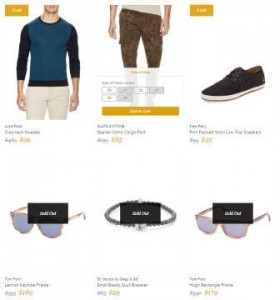 Websites. These days, it seems like almost every business has one. From your favorite local sushi place to your tried-and-true bookstore, every business, big or small, can be found online. Businesses today need to have an online presence if they want to reach potential buyers. This presence includes having a variety of social media accounts, such as Facebook, Twitter, LinkedIn, and Instagram—whatever will help leverage their website and reach the most people.
Websites. These days, it seems like almost every business has one. From your favorite local sushi place to your tried-and-true bookstore, every business, big or small, can be found online. Businesses today need to have an online presence if they want to reach potential buyers. This presence includes having a variety of social media accounts, such as Facebook, Twitter, LinkedIn, and Instagram—whatever will help leverage their website and reach the most people.
Your company’s website is its virtual storefront, and it often gives potential buyers their first impression of what your company has to offer. Websites aren’t just nice to have—they’re an integral part of your inbound marketing strategy and will help you turn visitors into customers. With a great website, you’ll be able to attract, educate, and convince visitors to buy your products or services.
So, you have a website and people know you exist—great. But simply having a website won’t cut it. You need to stand out, be easily accessible, and know how to optimize your pages. Your website is the key to your inbound marketing strategy, so you need to know what to do—and what not to do—to avoid making website mistakes that will cost you time, energy, and, ultimately, business. You get out what you put in, so to help you put the most in, this article will outline the 12 biggest website mistakes and how you can avoid making them. If you don’t know what you’re doing, it’s easy to make mistakes; but if you do your research and follow these tips, you’ll be getting to the top of search engine rankings in no time.
So, what are the 12 biggest website mistakes?
Website Mistake #1: Not optimizing your website pages for searching.
Optimization is the act, process, or methodology of making something as perfect or functional as possible. In terms of the “inbound world,” website optimization mainly refers to SEO. What is SEO? It’s the process of making your website as functional as possible to get the most traffic on search engines such as Google, Bing, or Yahoo. Just as described above, when your website is optimized, you’ll show up higher in search results, which will make people more likely to click on your website link. When optimizing your website, you’ll have to focus on using the right keywords, gaining quality inbound links, and employing other SEO tactics to get the top spot.
Website Mistake #2: Not optimizing your title tag and meta tags.
To truly optimize your website in terms of SEO, your title tag and meta tags must also be optimized. The title tag is an HTML element of a webpage that describes the content of the page. It’s one of the primary elements that search engine crawlers look at when evaluating that page’s relevance to a particular search term and when indexing pages. A meta tag is a line of code contained in the background of a webpage. Search engines look at meta tags to learn what a page is about. Both title tags and meta tags should contain keywords that will help increase your page ranking in search results.
Website Mistake #3: Not having any quality inbound links.
 According to HubSpot, an authority on inbound marketing and sales, “An inbound link is a link coming from another site to your own website. ‘Inbound’ is generally used by the person receiving the link.” Inbound links are necessary for search engine optimization (SEO) and referral traffic. The more inbound links you have, the higher your website will rank in search engine result pages. Think about it. When you search for something on Google, are you more likely to click the links at the top of the first page or the links on, say, page 5 or 15? I’m guessing it’s the links on the first page. This is why it’s so important to have quality inbound links; they will help get you the top spot in search results, making people much more likely to click on your page.
According to HubSpot, an authority on inbound marketing and sales, “An inbound link is a link coming from another site to your own website. ‘Inbound’ is generally used by the person receiving the link.” Inbound links are necessary for search engine optimization (SEO) and referral traffic. The more inbound links you have, the higher your website will rank in search engine result pages. Think about it. When you search for something on Google, are you more likely to click the links at the top of the first page or the links on, say, page 5 or 15? I’m guessing it’s the links on the first page. This is why it’s so important to have quality inbound links; they will help get you the top spot in search results, making people much more likely to click on your page.
Website Mistake #4: Not having a professional, trustworthy design and being inconsistent with colors, images, fonts, navigation messaging, and layout.
Now you have a website and traffic—yay! Your next order of business is to make sure these visitors stay long enough to consider buying your products or services. This means having a modern, professional, trustworthy website. As we mentioned earlier, your website gives potential buyers the first impression of your business, so it’s important to make it look good and reflect the quality of whatever you’re offering. Your website must look nice and be easy to navigate, so it’s important to be consistent with colors, images, layout, and navigation messaging. You want your website to have a certain flow to it, and going from one page to another or searching for things on your website should be seamless.
Website Mistake #5: Being more flashy than helpful.
On the same note as having a professional, trustworthy website with consistent design elements, you should also avoid being too flashy and over-the-top. The key is to strike a balance between form and function. While your website must look appealing and professional while being user friendly, it’s important not to make the mistake of going overboard with colors, images, fonts, and graphics. You don’t want to overwhelm your customers and scare them away; you want to invite them to explore (and stay on) your website. To avoid making this website mistake, focus on content first (that is, being helpful) and design second. While a pretty website might attract potential buyers, they won’t stay if there’s nothing of substance for them to take away.
Website Mistake #6: Not having a blog.
A blog is a great way to communicate with potential buyers and those browsing your website. Your blog should reflect the real, personable side of your business, and it should offer original, value-added content that can’t be found anywhere else. A blog is an additional way for you to complement your website and connect with your target audience. Having a blog allows you to:
- create fresh content (and more pages of content), which is great for SEO;
- become established as an industry authority and thought leader;
- drive more traffic and leads back to your website;
- converse and engage with your audience and customers; and
- receive valuable inbound links.
The takeaway? Blog often (and not always about yourself), be transparent, and offer value-added content with each post. Be interesting, and show the real side of your business.
Website Mistake #7: Not answering the big questions: who, what, and why (and where, if needed).
You have a website to help answer your potential customers’ questions: who, what, and why (and where, if needed). You can’t just stick information on your pages with the hope that your message will make itself clear. You need to know your target audience and write for them. Furthermore, you need to know what you can help them with and why they need your products or services. They’ve come to your page for a reason, and your job is to offer a solution to whatever problem they’re having. But you can’t just answer one of these questions; you need to answer them all, and these answers need to work together to focus your potential buyers upon what you have to offer. Otherwise, potential buyers will leave your page once they realize they can’t find exactly what they’re looking for.
Website Mistake #8: Only selling instead of selling and educating.
Ah, here’s a big one. Today’s buyers want to be educated, not sold to. They don’t want products or services shoved in their faces. They want to know about what you’re selling and why your product or service is best suited to fill their needs. When they’re considering your product, they’re thinking, “What’s in it for me?” To tell them, you need to offer more than just product content on your website. While product content must be product-specific, you should also offer educational (and valuable) forms of content such as ebooks, videos, infographics, and other types of content that will nurture prospects through your marketing and sales funnel until they are ready to buy. These days, it’s about more than just a sales pitch; it’s about offering unique and valuable information as well.
Website Mistake #9: Using jargon and corporate gobbledygook.
You’ve heard the phrases: “think outside the box,” “ducks in a row,” “core competency,” “window of opportunity” . . . the list goes on. Gobbledygook is eye roll-inducing jargon language—terms and phrases—that has been overused and abused, thus rendering it meaningless. You know how annoying such terms and phrases are, so avoid using them on your website.
Website Mistake #10: Only using one form of content.
Only have a website with one type of content? Yikes! That’s simply not enough to reach your target audience and expand beyond them. Since you’re probably an avid consumer of various forms of media yourself, you know how interesting and engaging it can make content. You should be using multiple forms of content, including videos, images, and podcasts. Your goal is to reach a wide audience, and the best way to do so is to appeal to an array of different people. This means you need to include various forms of media on your website since simple webpages don’t appeal to everyone. 
Website Mistake #11: Making your website and its content static instead of dynamic.
Static websites are boring; they’re just not relevant to today’s Internet culture. They represent the bare minimum of what a website should be. They’re very basic and plain, maybe with a few Flash graphics and a campaign—not much to get excited about. On top of that, their content isn’t shareable, so it doesn’t go very far. These days, websites should integrate search, social media, content, and blogging. They should be multifaceted and create a positive and interactive user experience. The user should be able to do more, not less, than they were expecting to on your website. And since users want to be educated, you need to add variety and interest to the information you present to them. Traffic from blogs, social media, and organic and paid search results end up being converted into leads or sales on your main website, which is why having a dynamic website is so crucial.
Website Mistake #12: Being clever instead of clear.
When being dynamic, it’s important to ensure that you’re getting your point across clearly and not focusing simply on being clever. While being clever can help attract potential customers to your page, it won’t keep them there. They need clear information that will, again, help solve their problem and tell them why your product or service is the best for them. Being clear also helps you appear more trustworthy and professional, which will only improve your image in the minds of potential customers. While you can be both clever and clear, first and foremost, make sure your content is flawless, specific, and transparent—then add a touch of wittiness.
Image sources: Daria Nepriakhina/stocksnap.io, Sylwia Bartyzel/stocksnap.io, BigStockPhoto.com
(282)










